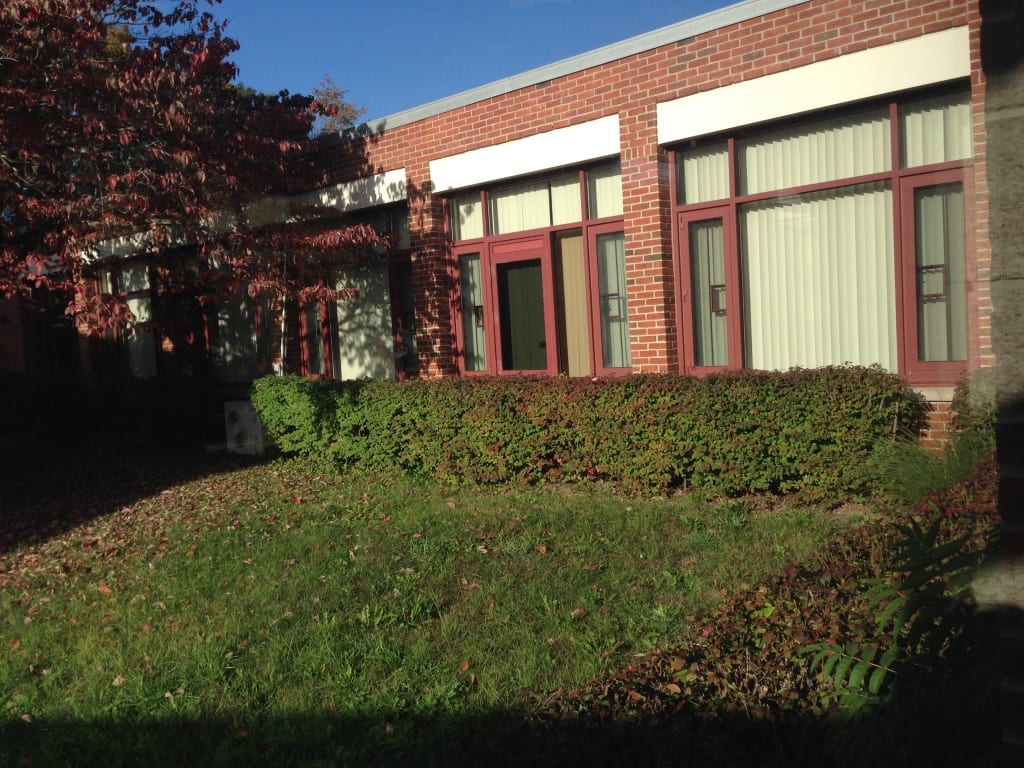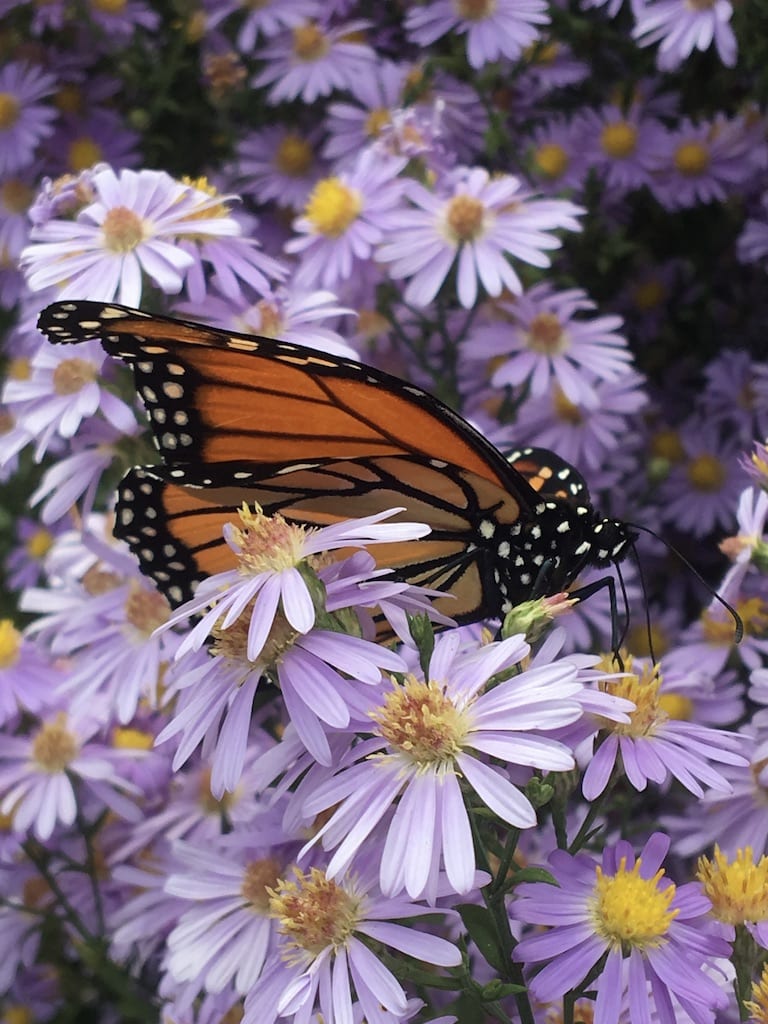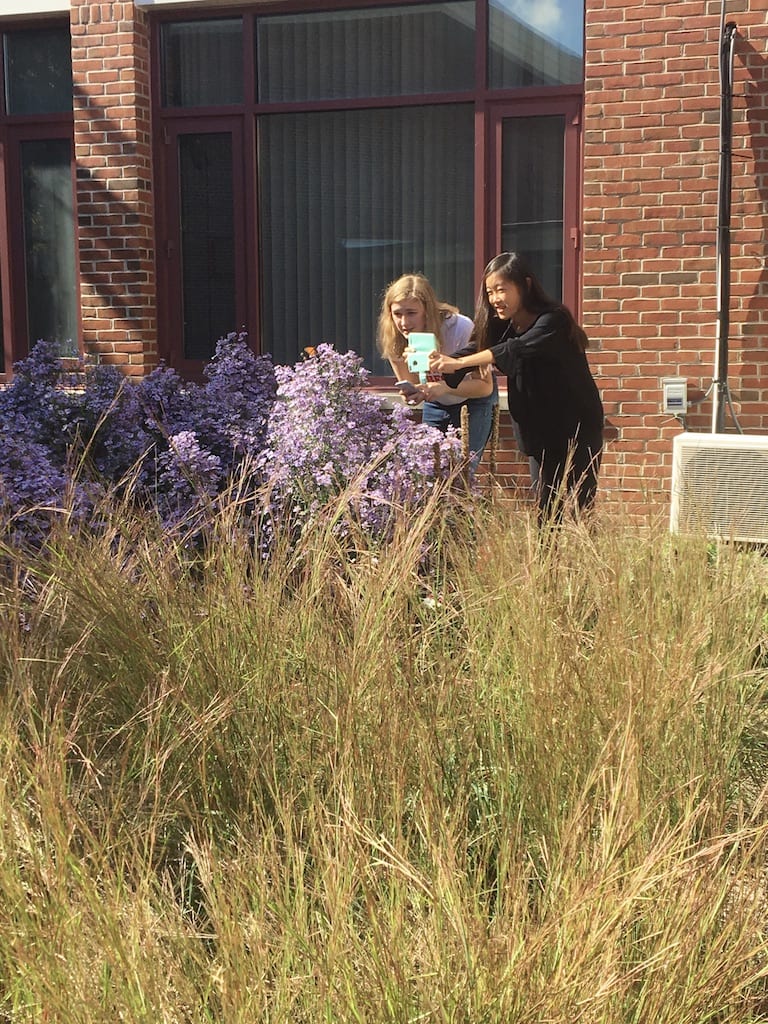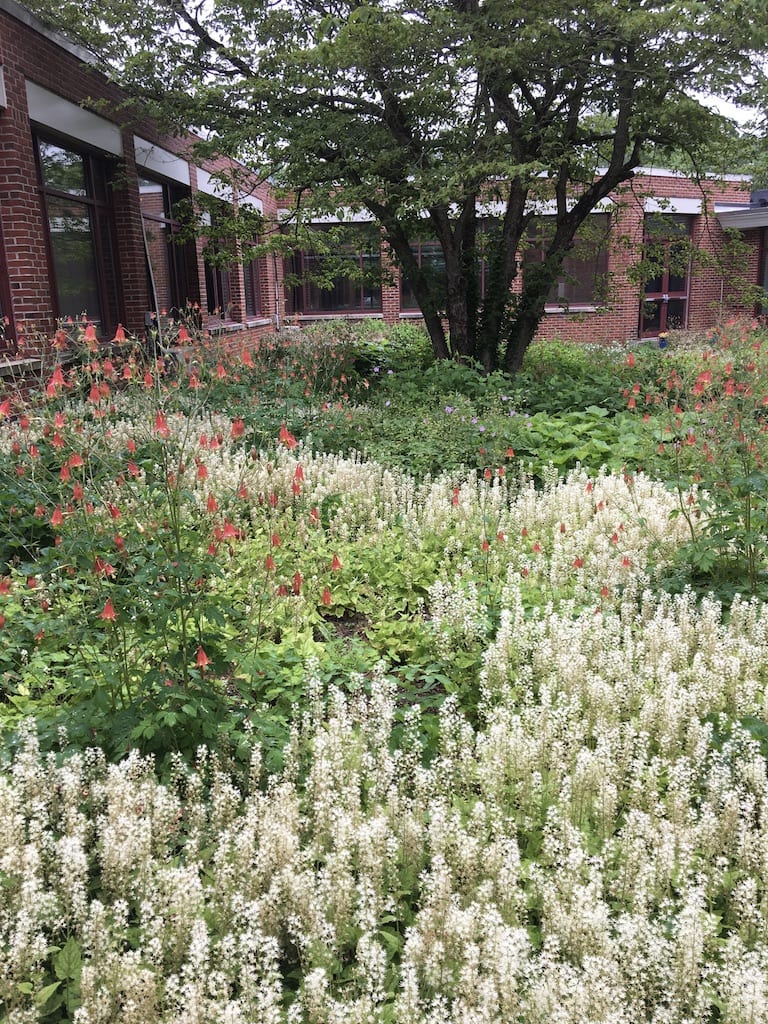by Missy Fabel
A lot can happen in a year, especially in High School. In the spring of 2017, a dozen students, a couple of faculty members and a handful of PTA parent volunteers planted more than 3,000 native plant plugs in an enclosed courtyard at Horace Greeley High School in Chappaqua, NY. The project was driven by one motivated parent volunteer.
After reading Doug Tallamy’s Bringing Nature Home, this parent convinced the district to remove the turf and hedge of burning bush (Euonymus alatus) that was in the courtyard and fund the plant material for what has now been christened The Greeley Native Plant Learning Garden (GNPLG). She brought me on board as a native plant expert and mother of three children in the district, the oldest of whom will be a sophomore this year and the youngest who is still in middle school. In other words. I would be at the school a long time.
This was an amazing opportunity for me to try my hand at an ecological design with a clean palette, testing my favorite ground covers as living mulches, building a plant community and having a front row seat to watch what happens over the next several years.
Maximizing School Interest

May 8, 2017: One month after planting, the dogwood, one of the few original plants, is a garden star.
Living in the Northeast, I knew right away that the garden needed to have a strong spring and fall season when school is in session. Of course, winter interest was also important and luckily there was already a mature dogwood (Cornus florida) present that had been planted in the 1970s.
There were academic goals to justify the expense of this garden, primarily what is known as “place-based” and “project-based learning.” The aim was for students and faculty to use the space for small outdoor classes, such as biology, environmental studies or art and photography. Me? I simply wanted to connect the students to native plants of the Northeast, create pollinator and butterfly habitat and chip away at our current culture of plant blindness, a term coined by the Botanical Society of America to bring awareness to the fact that most people don’t even notice the plants in their own backyard or understand the important role they play in “the biosphere, and in human affairs.”
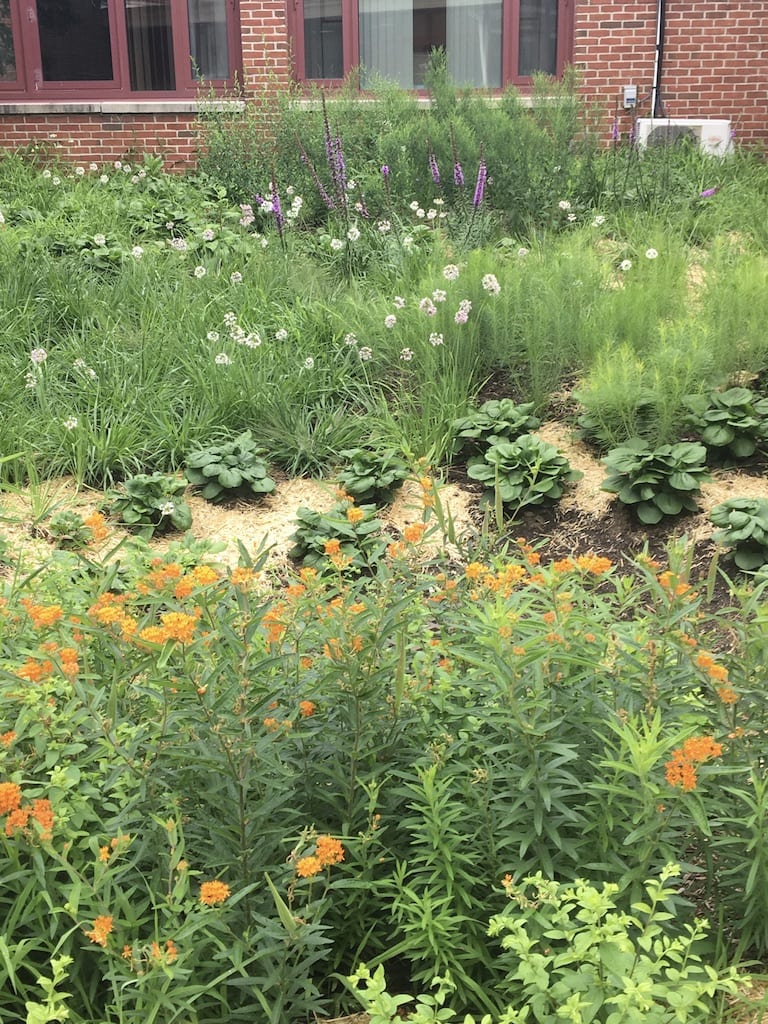
July 25, 2017: The Allium cernuum popping in the Eragrostis spectabilis provides seasonal interest and gives definition to the mass of this warm season grass.
Since the site had pockets of deep shade and a sunny corner, I decided to recreate a woodland transitioning into an open “meadow” or edge (ecotone). Weed suppression was a huge concern. Did I mention part of the deal for the courtyard was that the district/custodial staff would do no maintenance? Zero. The plan was to have a student club “adopt” and be responsible for the maintenance under the guidance of the Garden PTA Committee (which was basically me and three other dedicated moms). But I’ll get back to that later.
Covering Ground
For weed suppression, I knew I wanted two kinds of ground covers: those that spread quickly by stolons or rhizomes and those that are prolific self-sowers to fill in gaps. For the shadier areas, I chose a mixture of Canada ginger (Asarum canadense), foamflower (Tiarella cordifolia ‘Running Tapestry’) and bristle sedge (Carex eburnea). I sprinkled plugs of columbine (Aquilegia canadensis) and Virginia bluebells (Mertensia virginica) throughout both for their early spring bloom and their ability to self-sow.
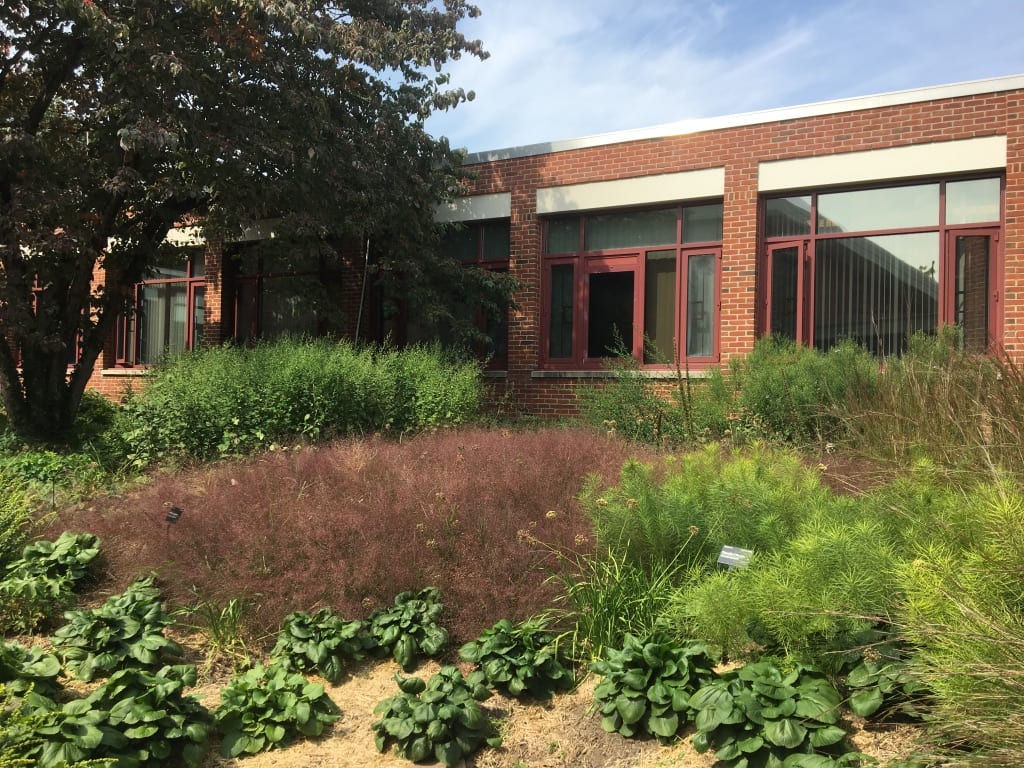
September 2017: The purple mass of flowering Eragrostis spectabilis hides the foliage of the senescing Allium cernuum and provides a striking contrast to the golden fall color of Amsonia hubricthii. Packera aurea planted in the foreground offers weed suppression; Symphyotrichum cordifolious in the background will bloom in October.
Masses of Christmas fern (Polystichum acrostichoides), marginal wood fern (Dryopteris marginalis) and alumroot (Heuchera villosa ‘Autumn Bride) were strategically planted for winter interest, weaving in and out of the woodland parts of the garden. Cranesbill (Geranium maculatum) provided spring color with heart-leaved aster (Symphyotrichum cordifolius) and autumn goldenrod (Solidago sphacelata ‘Golden Fleece’) brought up the rear for a spectacular fall show.
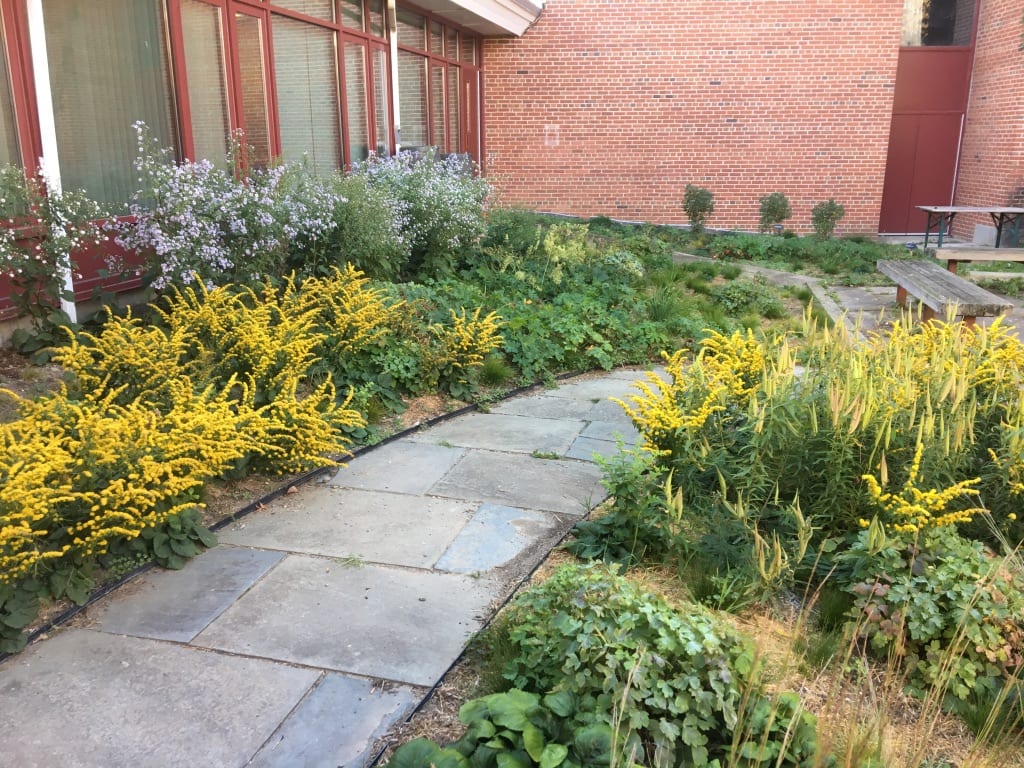
September 29, 2017: Its short stature and compact form make Solidago sphacelata an attractive ground cover that explodes into color in September.
The little bluestem (Schyzarium scoparium) and purple love grass (Eragrostis spectabilis), which form the backbone of the “meadow,” were underplanted with golden groundsel (Packera aurea) and nodding onion (Allium cernuum). I miscalculated the allium’s bloom time since it really doesn’t start flowering until end of July here in New York, but it still looks great popping up among the purple love grass, which can look a lot like crabgrass before it flowers in late summer.
The “meadow” was also planted with dense blazing star (Liatris spicata) and butterfly weed (Asclepias tuberosa) to provide a continual source of nectar for summer pollinators and host plants for monarch caterpillars. The threadleaf bluestar (Amsonia hubrichtii) is a nod to Horace Greeley school colors of blue and orange (butterfly weed) and works well with both the little bluestem and purple love grass as it turns golden in the fall. Smooth aster (Symphyotrichum laevis) with its showy purple flowers in fall dominates that sunny corner.
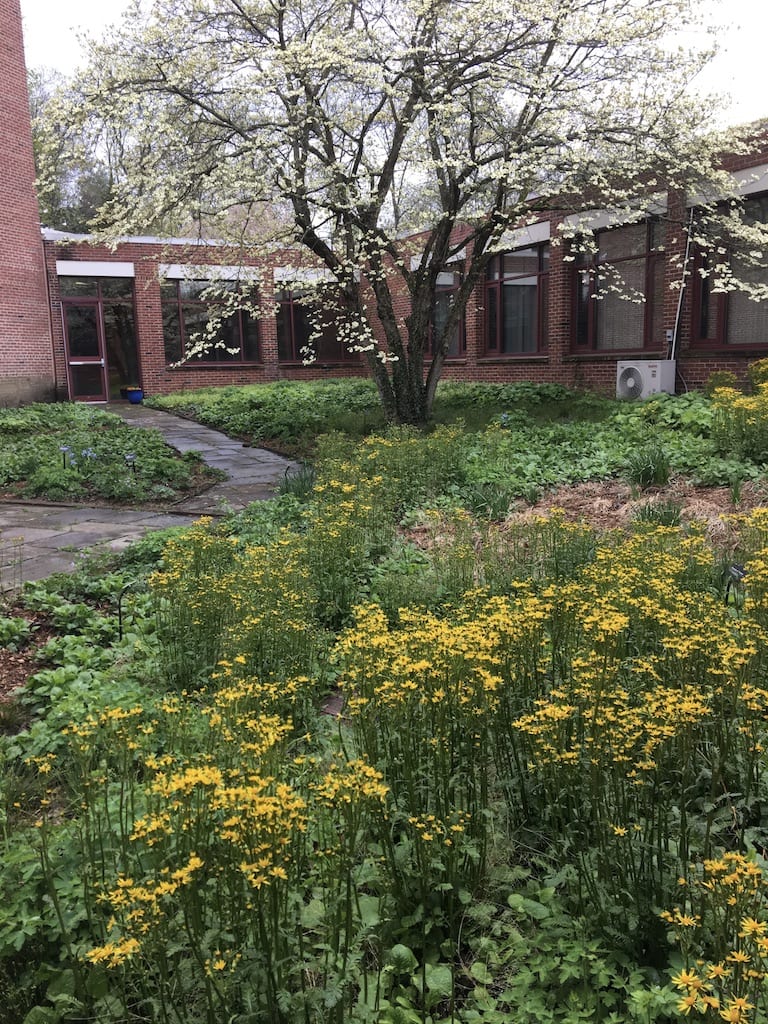
May 6, 2018: Semi-evergreen Packera aurea spreads rapidly, aiding in weed suppression as well as providing early spring color while the “meadow” grasses are still dormant.
Keeping Up
Planted the first week of April, the garden required some triage early on. We had to grab a garden hose, run it from the faucet in the bathroom down the hallway into the courtyard and attach it to a lawn sprinkler. The only other sources of water were two rain barrels that students had recently installed and would necessitate using watering cans to water by hand. I won’t pretend to remember weather details, but I do remember our good luck, getting a good soaking once a week from late spring or so until mid-summer when temperatures soared and the garden became overrun with crabgrass. The same motivated parent volunteer who spearheaded the garden project and I spent days and hours weeding around the plugs, telling ourselves that next year would be better, even as the sweat dripped liberally from our brows.
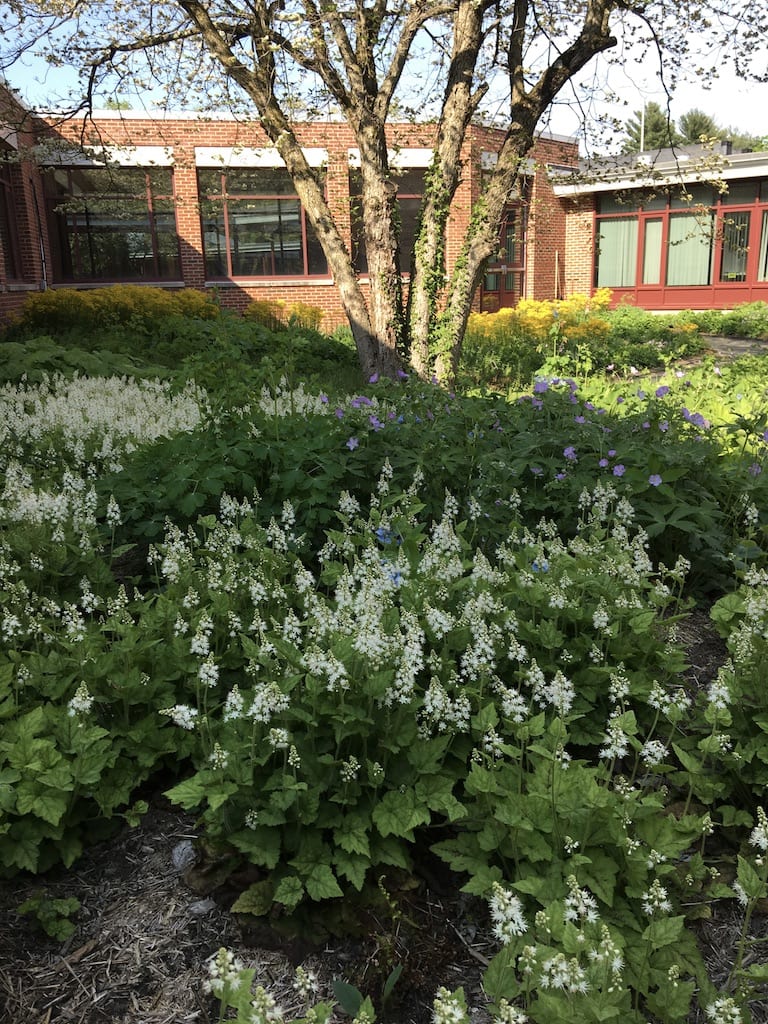
May 13, 2018. A carpet of Tiarella cordifolia ‘Running Tapestry’ gives the garden an expansive feel.
We were gratified as last fall the garden was a beautiful show of color and wildlife, particularly the bumblebees and monarch butterflies attracted to the asters. Students and faculty cutting through the courtyard would often stop to take pictures. My favorite interaction was with the custodian who took a short video of a monarch flitting about on the smooth aster. He told me he wanted to show his wife. Spring was equally exciting, especially the columbine popping up through the foamflower and reaching a height of five feet. Yes, five feet and it was not a cultivar.
The heart-leaved aster (Symphyotrichum cordifolius) also grew and grew and grew and I had to cut it back, cut it back and cut it back both last summer and this summer. It also seeded all about, so in retrospect, given the height and its propensity to self-sow, it was not the best choice for the space, though this year there is not one iota of crabgrass growing in it. Instead of weeding out crabgrass this summer, we are “editing” out aster where it does not work visually and letting it fill in the gaps where it does. And at least I can give the “edited” aster away. The Chappaqua Garden Club is first in line for its annual fall plant swap.
Long-term Plans
Getting back to maintenance as promised. A student group has yet to take full responsibility for the care of the garden, so it still falls to the PTA for upkeep: cutting back the grasses and perennial stems in late winter, keeping the patio weed free and edges clean. New furniture has been donated, making the space more usable and inviting for students and faculty. There are botanical plates and a new interpretative panel to introduce students to the plants and value of native plant communities. Just like the birds, bees and butterflies which arrived in the courtyard after it was planted with native plants last fall, I am hopeful that The Greeley Native Plant Learning Garden will inspire all who visit to stop to take a closer look and become active in the future of the garden. If you plant it, they will come.
About the Author
Missy Fabel holds a certificate in Field Botany from NYBG. She is a Steering Committee member of The Native Plant Center in Valhalla, NY, a nursery school teacher at Chappaqua Friends Nursery School, a Cornell Master Naturalist, and Native Plant Consultant and Designer. She can be reached at MissyFabel@yahoo.com or wakerobindesign@gmail.com.
***
Each author appearing herein retains original copyright. Right to reproduce or disseminate all material herein, including to Columbia University Library’s CAUSEWAY Project, is otherwise reserved by ELA. Please contact ELA for permission to reprint.
Mention of products is not intended to constitute endorsement. Opinions expressed in this newsletter article do not necessarily represent those of ELA’s directors, staff, or members.

